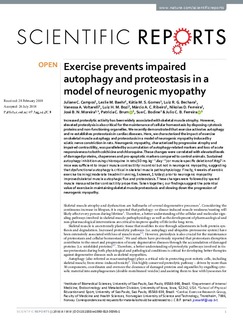| dc.contributor.author | Campos, Juliane C | |
| dc.contributor.author | Baehr, Leslie M | |
| dc.contributor.author | Gomes, Katia M S | |
| dc.contributor.author | Bechara, Luiz R.G. | |
| dc.contributor.author | Voltarelli, Vanessa | |
| dc.contributor.author | Bozi, Luiz H.M. | |
| dc.contributor.author | Ribeiro, Marcio AC | |
| dc.contributor.author | Ferreira, Nikolas D | |
| dc.contributor.author | Moreira, Jose Bianco Nascimento | |
| dc.contributor.author | Brum, Patricia C. | |
| dc.contributor.author | Bodine, Sue C | |
| dc.contributor.author | Ferreira, Julio CB | |
| dc.date.accessioned | 2019-09-19T07:04:44Z | |
| dc.date.available | 2019-09-19T07:04:44Z | |
| dc.date.created | 2019-01-31T11:29:33Z | |
| dc.date.issued | 2018 | |
| dc.identifier.citation | Scientific Reports. 2018, 8 . | nb_NO |
| dc.identifier.issn | 2045-2322 | |
| dc.identifier.uri | http://hdl.handle.net/11250/2617515 | |
| dc.description.abstract | Increased proteolytic activity has been widely associated with skeletal muscle atrophy. However, elevated proteolysis is also critical for the maintenance of cellular homeostasis by disposing cytotoxic proteins and non-functioning organelles. We recently demonstrated that exercise activates autophagy and re-establishes proteostasis in cardiac diseases. Here, we characterized the impact of exercise on skeletal muscle autophagy and proteostasis in a model of neurogenic myopathy induced by sciatic nerve constriction in rats. Neurogenic myopathy, characterized by progressive atrophy and impaired contractility, was paralleled by accumulation of autophagy-related markers and loss of acute responsiveness to both colchicine and chloroquine. These changes were correlated with elevated levels of damaged proteins, chaperones and pro-apoptotic markers compared to control animals. Sustained autophagy inhibition using chloroquine in rats (50 mg.kg−1.day−1) or muscle-specific deletion of Atg7 in mice was sufficient to impair muscle contractility in control but not in neurogenic myopathy, suggesting that dysfunctional autophagy is critical in skeletal muscle pathophysiology. Finally, 4 weeks of aerobic exercise training (moderate treadmill running, 5x/week, 1 h/day) prior to neurogenic myopathy improved skeletal muscle autophagic flux and proteostasis. These changes were followed by spared muscle mass and better contractility properties. Taken together, our findings suggest the potential value of exercise in maintaining skeletal muscle proteostasis and slowing down the progression of neurogenic myopathy. | nb_NO |
| dc.language.iso | eng | nb_NO |
| dc.publisher | Nature Research | nb_NO |
| dc.rights | Navngivelse 4.0 Internasjonal | * |
| dc.rights.uri | http://creativecommons.org/licenses/by/4.0/deed.no | * |
| dc.title | Exercise prevents impaired autophagy and proteostasis in a model of neurogenic myopathy | nb_NO |
| dc.type | Journal article | nb_NO |
| dc.type | Peer reviewed | nb_NO |
| dc.description.version | publishedVersion | nb_NO |
| dc.source.pagenumber | 14 | nb_NO |
| dc.source.volume | 8 | nb_NO |
| dc.source.journal | Scientific Reports | nb_NO |
| dc.identifier.doi | 10.1038/s41598-018-30365-1 | |
| dc.identifier.cristin | 1670084 | |
| dc.description.localcode | pen Access This article is licensed under a Creative Commons Attribution 4.0 International License, which permits use, sharing, adaptation, distribution and reproduction in any medium or format, as long as you give appropriate credit to the original author(s) and the source, provide a link to the Creative Commons license, and indicate if changes were made. | nb_NO |
| cristin.unitcode | 194,65,25,0 | |
| cristin.unitname | Institutt for sirkulasjon og bildediagnostikk | |
| cristin.ispublished | true | |
| cristin.fulltext | original | |
| cristin.qualitycode | 1 | |

